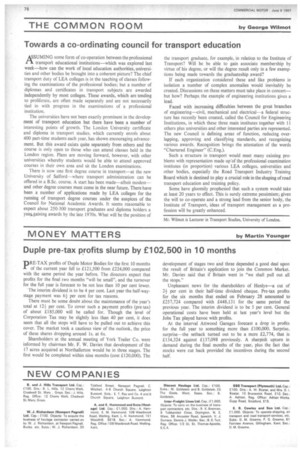THE COMMON ROOM
Page 78

If you've noticed an error in this article please click here to report it so we can fix it.
by George Wilmot
Towards a co-ordinating council for transport education
ASUMING some form of co-operation between the professional transpoit educational institutions—which was explored last week—how can the work of local education authorities, universities and other bodies be brought into a coherent picture? The chief transport duty of LEA colleges is in the teaching of classes following the examinations of the professional bodies; but a number of diplomas and certificates in transport subjects are awarded independently by most colleges. These awards, which are tending to proliferate, are often made separately and are not necessarily tied in with progress in the examinations of a professional institution.
The universities have not been exactly prominent in the development of transport education but there have been a number of interesting points of growth. The London University certificate and diploma in transport studies, which currently enrols about 400 part-time students each year, has shown encouraging advancement. But this award exists quite separately from others and the course is only open to those who can attend classes held in the London region. Plans are moving forward, however, with other universities whereby students would be able to attend approved courses in their own area and sit the London examinations.
There is now one first degree course in transport—at the new University of Salford—where transport administration can be offered in a B.Sc. course. A start has been made—albeit modest— and other degree courses must come in the near future. There have been a number of applications made by LEA colleges for the running of transport degree courses under the auspices of the Council for National Academic Awards. It seems reasonable to expect about 250-300 transport graduates and diploma holders a yeas gaining awards by the late 1970s. What will be the position of the transport graduate, for example, in relation to the Institute of Transport? Will he be able to gain associate membership by virtue of his degree, or will the degree result only in a few exemptions being made towards the graduateship award?
If each organization considered these and like problems in isolation a number of complex anomalies would inevitably be created. Discussions on these matters must take place in concert— but how? Perhaps, the example of engineering institutions gives a lead.
Faced with increasing difficulties between the great branches of engineering—civil, mechanical and electrical—a federal structure has recently been created, called the Council for Engineering Institutions, in which these three main institutes together with 11 others plus universities and other interested parties are represented. The new Council is defining areas of function, reducing overlapping, approving and classifying standards, and recognizing various awards. Recognition brings the attestation of the words "Chartered Engineer" (C.Eng.).
Such a structure in transport would meet many existing problems with representation made up"of the professional examination institutes (in proportion) various LEA colleges, universities and other bodies, especially the Road Transport Industry Training Board which is destined to play a crucial role in the shaping of road transport education and training policy.
Some have gloomily prophesied that such a system would take at least 20 years to effect. This is surely extreme pessimism; given the will to co-operate and a strong lead from the senior body, the Institute of Transport, ideas of transport management as a profession will be greatly enhanced.




























































































































